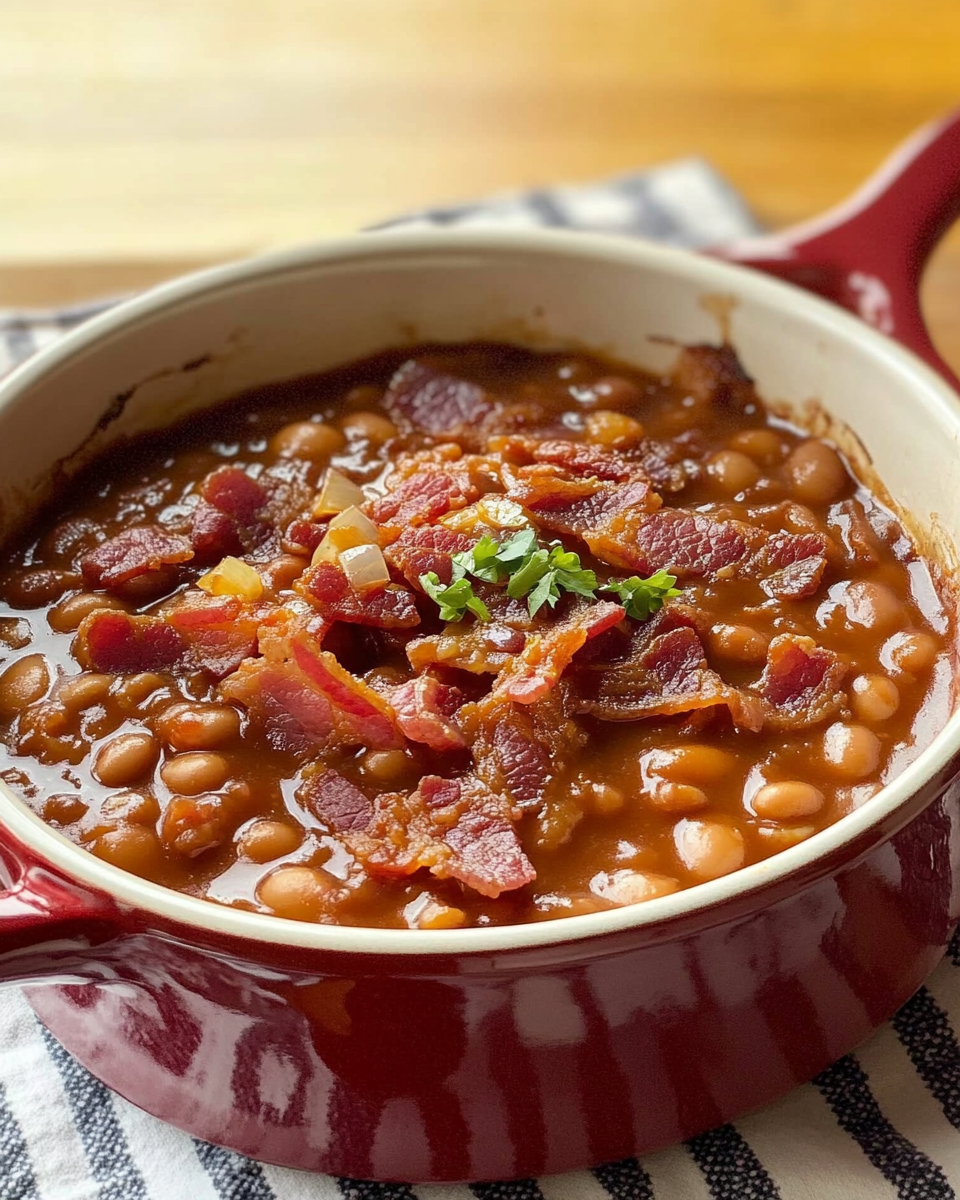These baked beans bring together a perfect balance of sweet, smoky, and savory flavors that elevate any meal. The tender beans soak up the rich molasses and tangy ketchup sauce, while crispy bacon adds a delightful crunch and smoky depth. Served warm in a rustic bowl, they make an irresistible side dish for backyard barbecues, holiday feasts, or any comforting family gathering.
What makes this recipe special is its simplicity combined with deep, soulful flavors. Slow baking allows the beans to absorb all the seasonings and create a thick, luscious sauce that clings to every bite. It’s a classic Southern staple reinvented for today’s home cook who wants maximum flavor with minimal fuss.
Full recipe:
Ingredients:
-
1 lb dry navy beans (or Great Northern beans), soaked overnight and drained
-
6 slices bacon, diced
-
1 medium onion, finely chopped
-
1/2 cup ketchup
-
1/4 cup molasses
-
1/4 cup brown sugar, packed
-
1 tablespoon yellow mustard
-
2 teaspoons Worcestershire sauce
-
1 teaspoon salt
-
1/2 teaspoon black pepper
-
2 cups water (plus more as needed)
Directions:
-
Preheat oven to 300°F (150°C).
-
In a large pot, cover soaked beans with fresh water and bring to a boil. Simmer for about 1 hour until beans are tender but not mushy. Drain and set aside.
-
In a large oven-safe pot or Dutch oven, cook diced bacon over medium heat until crispy. Remove bacon with a slotted spoon and set aside, leaving the bacon fat in the pot.
-
Add chopped onion to the bacon fat and sauté until soft and translucent, about 5 minutes.
-
Stir in ketchup, molasses, brown sugar, mustard, Worcestershire sauce, salt, and pepper until combined.
-
Add cooked beans and crispy bacon back into the pot. Pour in 2 cups of water and stir gently to combine.
-
Cover the pot with a lid or foil and bake in the oven for 2 to 3 hours, stirring every 30 minutes and adding more water if the beans get too dry. The beans should be thick and saucy when done.
-
Remove from oven and let rest for 10 minutes before serving.
Prep Time: 15 minutes (plus soaking and simmering) | Cooking Time: 2.5 hours | Total Time: ~3 hours | Kcal: 350 kcal per serving | Servings: 6 servings
Why This Recipe Stands Out
What makes this particular version of baked beans so remarkable is its authentic Southern flair combined with a simple yet deeply flavorful ingredient list. The use of molasses and brown sugar adds a natural sweetness that perfectly complements the savory, smoky notes of crisp bacon. Many baked bean recipes tend to either be too sweet or too bland, but this one strikes a perfect balance, making it both comforting and exciting to the palate.
The slow cooking process is another key factor that elevates this dish. Allowing the beans to bake slowly in the oven enables them to absorb the flavors of the sauce and bacon fat thoroughly. This results in a luscious, thick sauce that clings to every tender bean, creating a dish that is both hearty and satisfying. Unlike canned baked beans, which can sometimes taste flat or overly processed, these homemade baked beans burst with fresh, vibrant flavors.
The Role of Ingredients in Flavor and Texture
While the recipe calls for relatively simple ingredients, each plays a crucial role in creating the overall taste and texture. Navy beans (or Great Northern beans) are preferred because of their creamy texture once cooked and their ability to soak up flavors without falling apart. The diced bacon not only adds a wonderful smokiness but also imparts fat that enriches the sauce.
Molasses is an essential ingredient, giving the beans their signature deep, rich sweetness with a slight bitterness that prevents the dish from being cloying. Brown sugar enhances this sweetness while adding a subtle caramel undertone. Ketchup and mustard bring acidity and tang, helping to cut through the richness of the bacon and sugar. Worcestershire sauce adds umami depth, rounding out the savory profile.
Cooking Techniques and Tips
Patience is key when making baked beans from scratch. Soaking the beans overnight helps reduce cooking time and ensures the beans cook evenly without cracking. Parboiling the beans before baking softens them up and prevents them from becoming mushy in the oven.
Using a heavy oven-safe pot, such as a Dutch oven, ensures even heat distribution, which is crucial for slow baking. Covering the pot helps retain moisture, preventing the beans from drying out. However, occasional stirring during baking helps check the moisture level and prevents sticking.
Adding water during baking might be necessary if the beans start to dry out. The goal is a thick, saucy consistency, not a dry bake. The beans should be tender but maintain their shape — creamy yet firm.
Serving Suggestions and Pairings
Baked beans are incredibly versatile and pair beautifully with a wide range of dishes. They are a classic accompaniment to barbecues and grilled meats such as ribs, pulled pork, or brisket, complementing smoky flavors perfectly. They also work well alongside fried chicken, roasted vegetables, cornbread, or coleslaw for a complete Southern-style meal.
This dish is equally suitable as a hearty side for a casual weeknight dinner or a festive holiday gathering. You can serve it straight from the pot or transfer it to a rustic serving bowl for a charming presentation. Leftovers taste even better the next day, making baked beans an excellent dish to prepare in advance.
Variations and Customization
One of the beauties of baked beans is how easy it is to tweak the recipe to suit different tastes and dietary needs. For example, swapping bacon for smoked turkey or a plant-based bacon substitute can make the dish leaner or vegetarian-friendly without sacrificing flavor. Adjusting the sweetness by varying the molasses or sugar levels allows you to personalize the taste.
Adding spices such as smoked paprika, chili powder, or a dash of cayenne can introduce a subtle heat and complexity. Fresh herbs like thyme or rosemary can also be stirred in before baking for an aromatic twist. For those who enjoy tangier beans, a splash of apple cider vinegar added near the end of cooking brightens the flavors beautifully.
Nutritional Benefits and Considerations
Beans are an excellent source of plant-based protein, fiber, and important nutrients such as iron, magnesium, and folate. This makes baked beans a nutritious addition to any meal, helping with digestion and promoting heart health. The inclusion of bacon increases fat and calorie content, so adjusting the amount or choosing leaner options can help if you’re mindful of those factors.
Because this recipe is made from scratch, it avoids the preservatives and excessive sodium found in many canned baked beans. You have full control over the ingredients, allowing you to make a healthier version while keeping the comforting taste intact.
The Emotional and Cultural Connection
Baked beans are more than just a dish — they represent family, tradition, and community. For many people, the smell of slow-cooked baked beans evokes memories of backyard barbecues, holiday dinners, or Sunday suppers with loved ones. Sharing a pot of these beans is sharing a piece of culinary heritage that brings people together. This recipe carries that spirit forward, making it easy to recreate those moments of connection and comfort in your own kitchen.
Conclusion
Making baked beans from scratch may take some time, but the reward is a dish full of warmth, flavor, and nostalgia. This recipe perfectly captures the essence of Southern cooking — simple ingredients transformed through patience and care into something truly special. Whether you’re serving it alongside ribs at a summer cookout or enjoying it as a cozy winter side, these baked beans deliver a delicious, hearty experience that’s sure to satisfy.
Taking the time to prepare baked beans yourself also means you can customize every element, from sweetness to smokiness, ensuring it fits your taste preferences perfectly. The next time you want a comforting, crowd-pleasing side dish, give this recipe a try — your family and friends will thank you.






